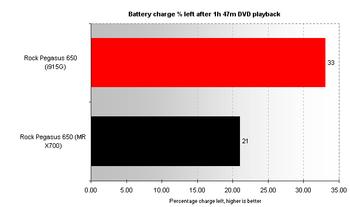Battery considerations and overall thoughts
Battery considerationsWe've made mention that the Rockdirect Pegasus 650 can use either onboard, integrated Intel i915G graphics or, at the flick of a switch, turn on decent gaming potential via ATI's Mobility Radeon X700 128MB card. ATI and NVIDIA tout mobile power-saving features almost as much as pure GPU grunt, so it was interesting to compare laptop battery life, in 2D mode, with the onboard graphics and MR X700 set to maximum battery mode.
The test was simple enough. The Pegasus 650 was charged to maximum and then a 1-hour 47-minute DVD was run, in full-screen mode and from the laptop's DVD drive, with screen brightness turned down to medium, battery mode set to maximum efficiency, and wireless connectivity switched off. We wanted to see just how much battery life, when run via both integrated and discrete graphics, was left at the end of the DVD.

The above results were obtained using a standard 6-cell 4400maH battery. Using the optional 9-cell 6600maH battery would increase the battery life's longevity. What seems clear is that the battery toll of using a discrete graphics card, no matter how good its power-saving techniques, isn't going to be as good as Intel's onboard's. That's why if you're not gaming, it makes sense to switch, literally, to internal VGA. The IQ is just as good and battery life is that much longer.
Final thoughts
Rockdirect's Pegasus is a laptop that does well in most areas. It's not tied down by the extra weight associated with pure desktop-replacement models, yet, thanks to a novel 5% guaranteed overclocking feature, offers you the performance associated with the next processor up in the Pentium M line at no extra cost. Pure CPU performance, then, is excellent. The use of ATI's Mobility Radeon X700 MXM graphics card offers reasonable gaming performance for the money, although you probably won't be able to run the latest game at the laptop's native WSXGA+ setting. The Pegasus 650's battery life is enhanced by another novel feature, that is, the ability to toggle between onboard and discrete graphics at the flick of a front-mounted switch. Neat, eh?
Rockdirect, then, has most of the bases covered with its Pegasus 650 model. It's fast, quiet, reasonably portable, and, subjectively-speaking, looks good, as well. The review model, priced at £1199+VAT, is at the top-end of the Pegasus 650 range which starts off at a slightly more modest £999+VAT. In an ideal world, we'd liked to have seen the Pegasus 650 tip the scales at, say, 2.5kg, thereby making it a true thin-and-light laptop. That's about it, really.
Summing it all up, if you're in need of a high-end, portable laptop that's somewhat different from the homogeneous notebooks that litter the market, Rockdirect's Pegasus 650 is a pretty good choice right now. We can see a few students blowing their loans on one!







